


China launches the Shenzhou-22 spaceship from the Jiuquan Satellite Launch Center in northwest China on Nov. 25, 2025. (Photo by Li Minggang/Xinhua)
JIUQUAN, Nov. 25 (Xinhua) -- China launched the Shenzhou-22 spaceship from the Jiuquan Satellite Launch Center in northwest China at 12:11 p.m. (Beijing Time) on Tuesday, successfully accomplishing the first emergency launch mission in the country's manned space program.
About 10 minutes after the launch, the spaceship separated from the rocket and entered its designated orbit. The China Manned Space Agency declared the launch mission a complete success.
The spaceship, flying without a crew aboard, carried a cargo of space food, medical supplies, fresh fruit and vegetables, as well as devices for treating the cracked window on the Shenzhou-20 spaceship.
Shenzhou-22 will autonomously execute a fast-track rendezvous and docking with the space station complex.
The new spaceship will later serve as the return vessel for the three Shenzhou-21 astronauts currently in orbit.
The return mission of sending the three Shenzhou-20 astronauts back to Earth, initially scheduled on Nov. 5 by the Shenzhou-20 spaceship, was delayed following a suspected debris impact.
The Long March-2F Y22 rocket and the Shenzhou-22 spaceship -- already on standby at the launch site -- were swiftly brought to launch readiness, initiating a 16-day emergency launch sequence. ■

China launches the Shenzhou-22 spaceship from the Jiuquan Satellite Launch Center in northwest China on Nov. 25, 2025. (Xinhua/Li Minggang)

China launches the Shenzhou-22 spaceship from the Jiuquan Satellite Launch Center in northwest China on Nov. 25, 2025. (Xinhua/Li Minggang)

China launches the Shenzhou-22 spaceship from the Jiuquan Satellite Launch Center in northwest China on Nov. 25, 2025. (Photo by Wang Jiangbo/Xinhua)
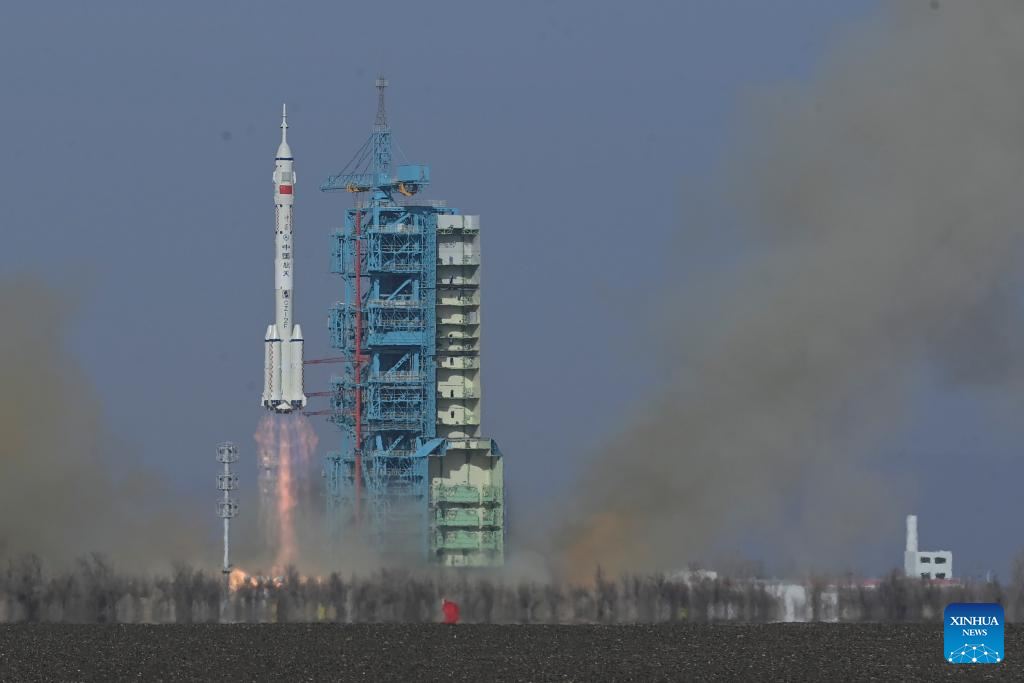
China launches the Shenzhou-22 spaceship from the Jiuquan Satellite Launch Center in northwest China on Nov. 25, 2025. (Photo by Wang Jiangbo/Xinhua)
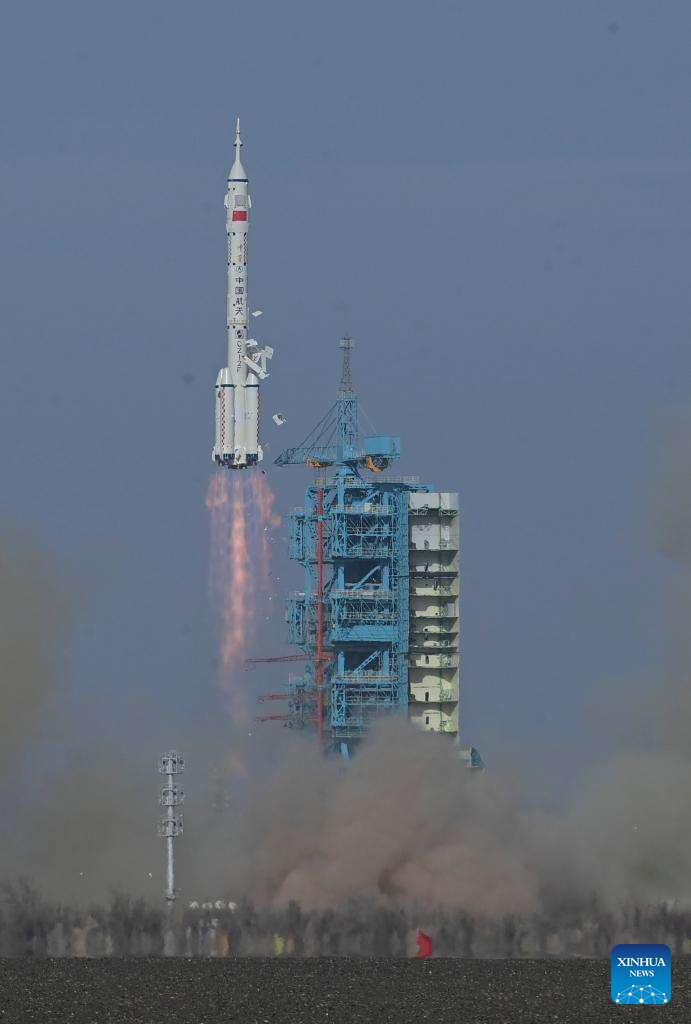
China launches the Shenzhou-22 spaceship from the Jiuquan Satellite Launch Center in northwest China on Nov. 25, 2025. (Photo by Wang Jiangbo/Xinhua)
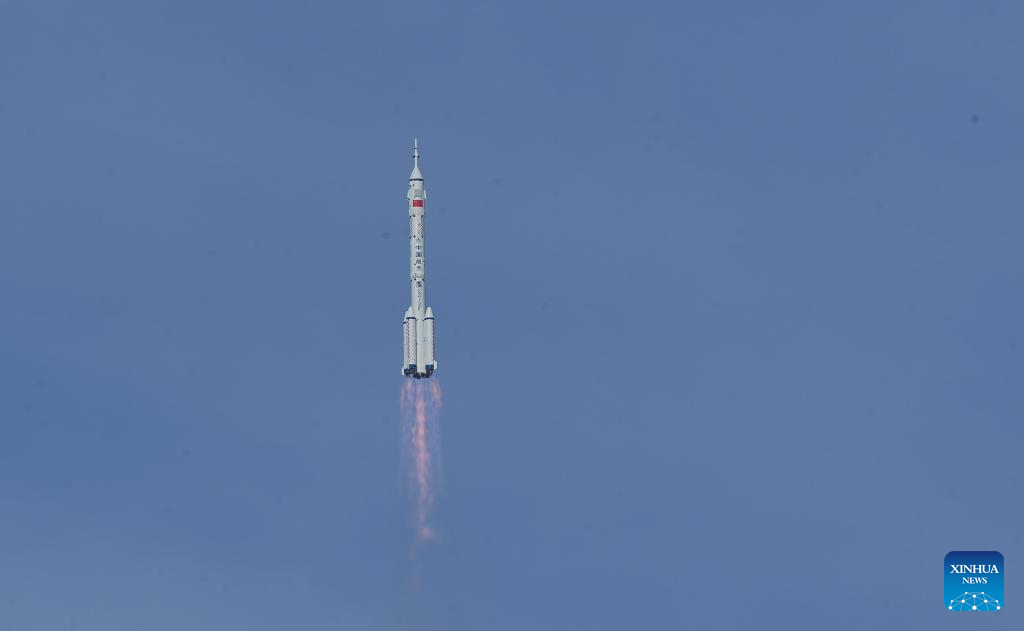
China launches the Shenzhou-22 spaceship from the Jiuquan Satellite Launch Center in northwest China on Nov. 25, 2025. (Photo by Wang Jiangbo/Xinhua)

The Shenzhou-22 spaceship, atop a Long March-2F Y22 rocket, blasts off from the Jiuquan Satellite Launch Center in northwest China, Nov. 25, 2025. China launched the Shenzhou-22 spaceship from the Jiuquan Satellite Launch Center in northwest China at 12:11 p.m. (Beijing Time) on Tuesday, successfully accomplishing the first emergency launch mission in the country's manned space program.
About 10 minutes after the launch, the spaceship separated from the rocket and entered its designated orbit. The China Manned Space Agency declared the launch mission a complete success. (Xinhua/Lian Zhen)
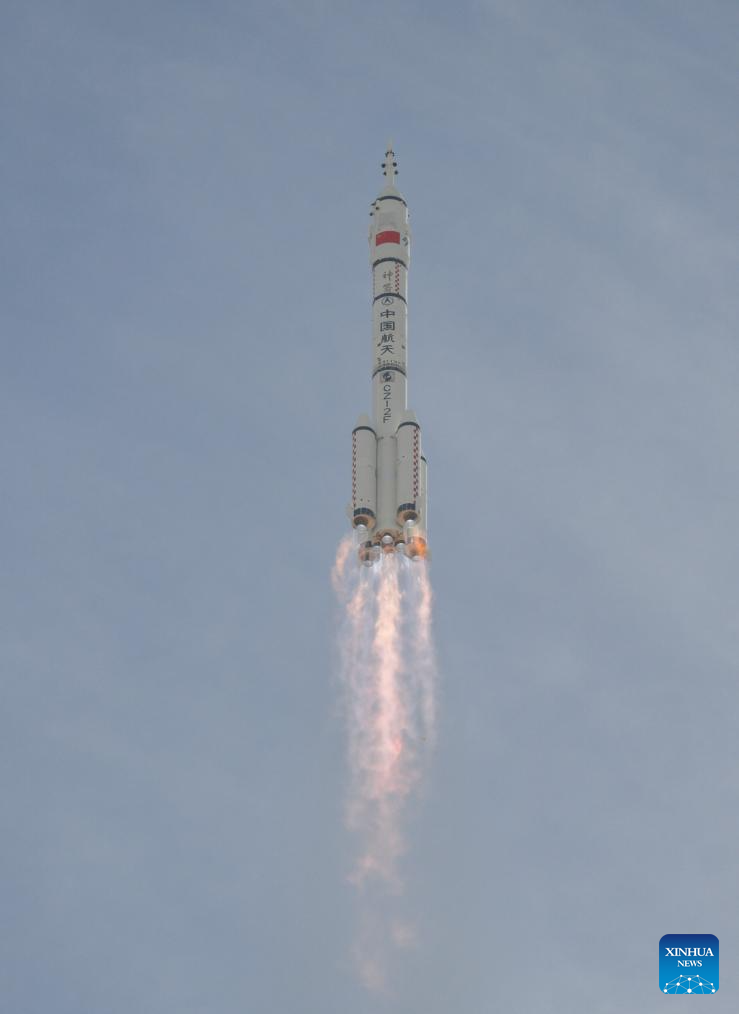
The Shenzhou-22 spaceship, atop a Long March-2F Y22 rocket, blasts off from the Jiuquan Satellite Launch Center in northwest China, Nov. 25, 2025. China launched the Shenzhou-22 spaceship from the Jiuquan Satellite Launch Center in northwest China at 12:11 p.m. (Beijing Time) on Tuesday, successfully accomplishing the first emergency launch mission in the country's manned space program.
About 10 minutes after the launch, the spaceship separated from the rocket and entered its designated orbit. The China Manned Space Agency declared the launch mission a complete success. (Xinhua/Lian Zhen)
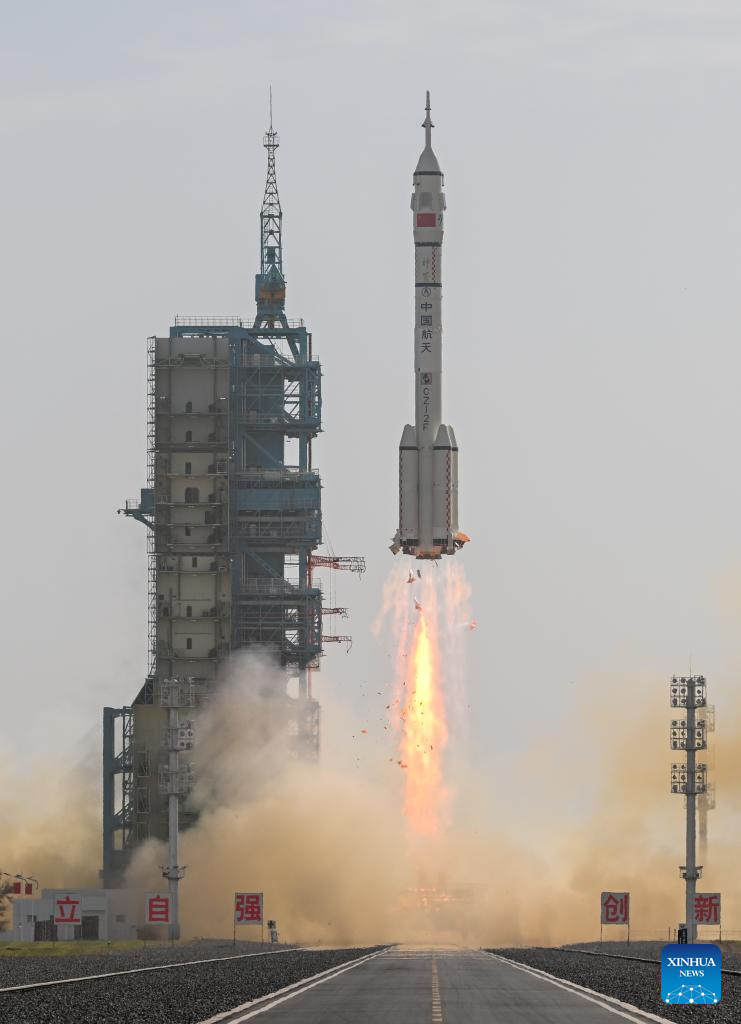
The Shenzhou-22 spaceship, atop a Long March-2F Y22 rocket, blasts off from the Jiuquan Satellite Launch Center in northwest China, Nov. 25, 2025. China launched the Shenzhou-22 spaceship from the Jiuquan Satellite Launch Center in northwest China at 12:11 p.m. (Beijing Time) on Tuesday, successfully accomplishing the first emergency launch mission in the country's manned space program.
About 10 minutes after the launch, the spaceship separated from the rocket and entered its designated orbit. The China Manned Space Agency declared the launch mission a complete success. (Xinhua/Lian Zhen)
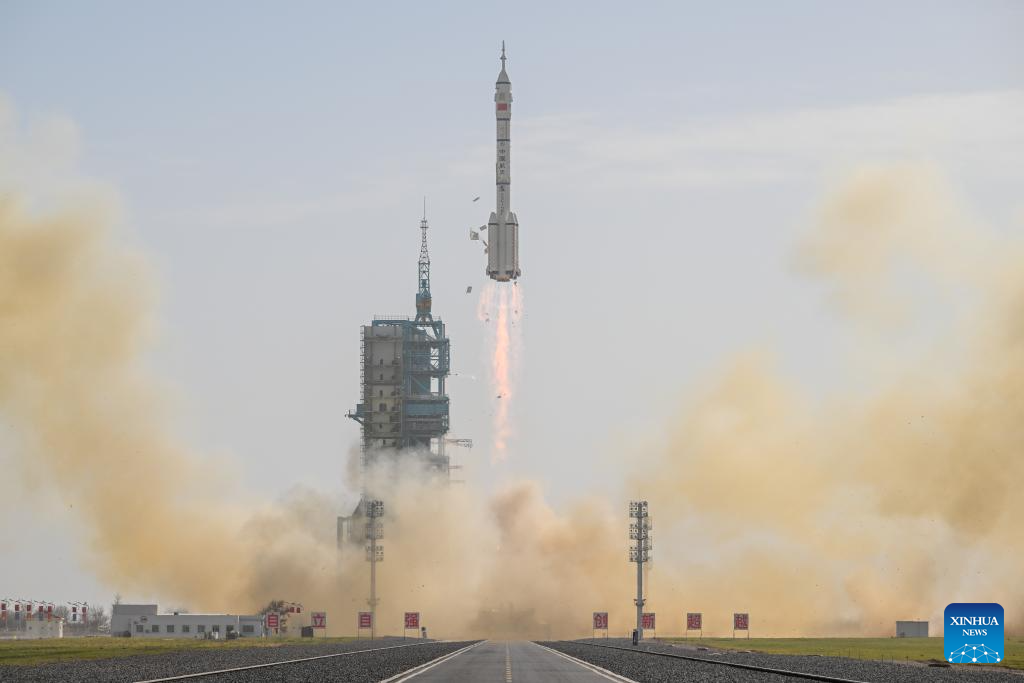
The Shenzhou-22 spaceship, atop a Long March-2F Y22 rocket, blasts off from the Jiuquan Satellite Launch Center in northwest China, Nov. 25, 2025. China launched the Shenzhou-22 spaceship from the Jiuquan Satellite Launch Center in northwest China at 12:11 p.m. (Beijing Time) on Tuesday, successfully accomplishing the first emergency launch mission in the country's manned space program.
About 10 minutes after the launch, the spaceship separated from the rocket and entered its designated orbit. The China Manned Space Agency declared the launch mission a complete success. (Xinhua/Lian Zhen)
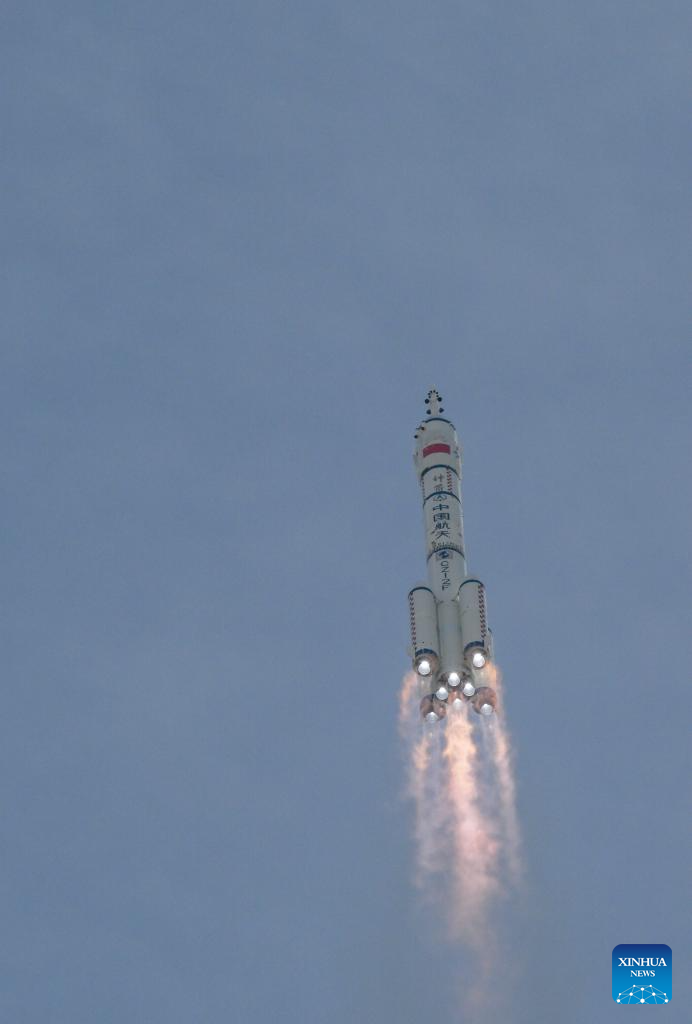
The Shenzhou-22 spaceship, atop a Long March-2F Y22 rocket, blasts off from the Jiuquan Satellite Launch Center in northwest China, Nov. 25, 2025. China launched the Shenzhou-22 spaceship from the Jiuquan Satellite Launch Center in northwest China at 12:11 p.m. (Beijing Time) on Tuesday, successfully accomplishing the first emergency launch mission in the country's manned space program.
About 10 minutes after the launch, the spaceship separated from the rocket and entered its designated orbit. The China Manned Space Agency declared the launch mission a complete success. (Xinhua/Lian Zhen)

The Shenzhou-22 spaceship, atop a Long March-2F Y22 rocket, blasts off from the Jiuquan Satellite Launch Center in northwest China, Nov. 25, 2025. China launched the Shenzhou-22 spaceship from the Jiuquan Satellite Launch Center in northwest China at 12:11 p.m. (Beijing Time) on Tuesday, successfully accomplishing the first emergency launch mission in the country's manned space program.
About 10 minutes after the launch, the spaceship separated from the rocket and entered its designated orbit. The China Manned Space Agency declared the launch mission a complete success. (Xinhua/Lian Zhen)

The Shenzhou-22 spaceship, atop a Long March-2F Y22 rocket, blasts off from the Jiuquan Satellite Launch Center in northwest China, Nov. 25, 2025. China launched the Shenzhou-22 spaceship from the Jiuquan Satellite Launch Center in northwest China at 12:11 p.m. (Beijing Time) on Tuesday, successfully accomplishing the first emergency launch mission in the country's manned space program.
About 10 minutes after the launch, the spaceship separated from the rocket and entered its designated orbit. The China Manned Space Agency declared the launch mission a complete success. (Xinhua/Lian Zhen)

The Shenzhou-22 spaceship, atop a Long March-2F Y22 rocket, blasts off from the Jiuquan Satellite Launch Center in northwest China, Nov. 25, 2025. China launched the Shenzhou-22 spaceship from the Jiuquan Satellite Launch Center in northwest China at 12:11 p.m. (Beijing Time) on Tuesday, successfully accomplishing the first emergency launch mission in the country's manned space program.
About 10 minutes after the launch, the spaceship separated from the rocket and entered its designated orbit. The China Manned Space Agency declared the launch mission a complete success. (Xinhua/Lian Zhen)
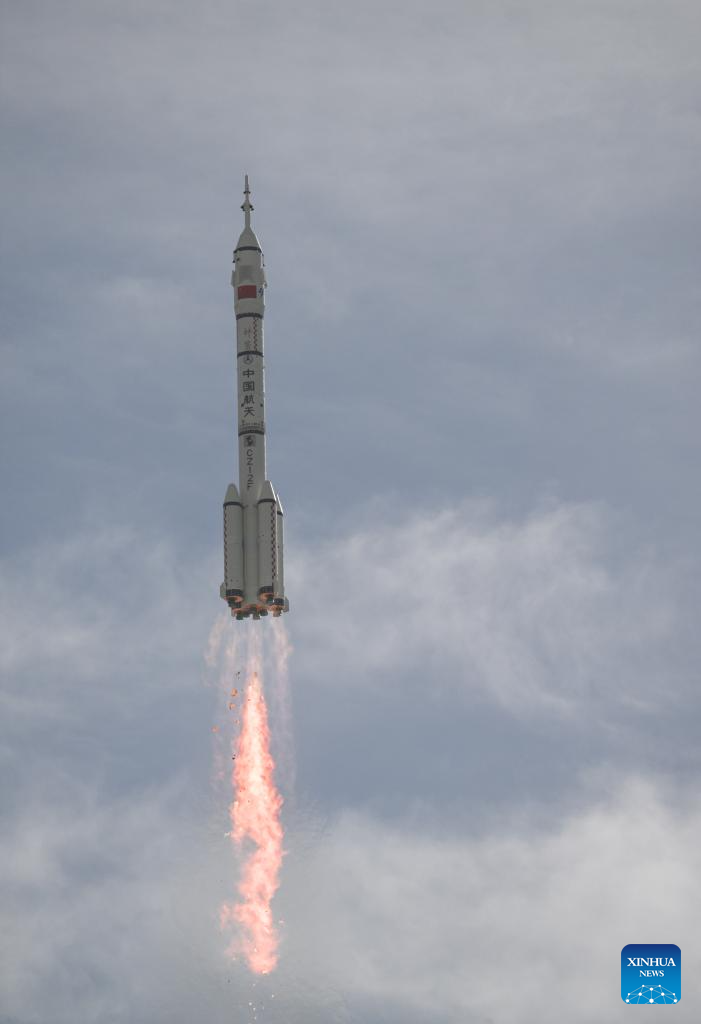
The Shenzhou-22 spaceship, atop a Long March-2F Y22 rocket, blasts off from the Jiuquan Satellite Launch Center in northwest China, Nov. 25, 2025. China launched the Shenzhou-22 spaceship from the Jiuquan Satellite Launch Center in northwest China at 12:11 p.m. (Beijing Time) on Tuesday, successfully accomplishing the first emergency launch mission in the country's manned space program.
About 10 minutes after the launch, the spaceship separated from the rocket and entered its designated orbit. The China Manned Space Agency declared the launch mission a complete success. (Xinhua/Lian Zhen)
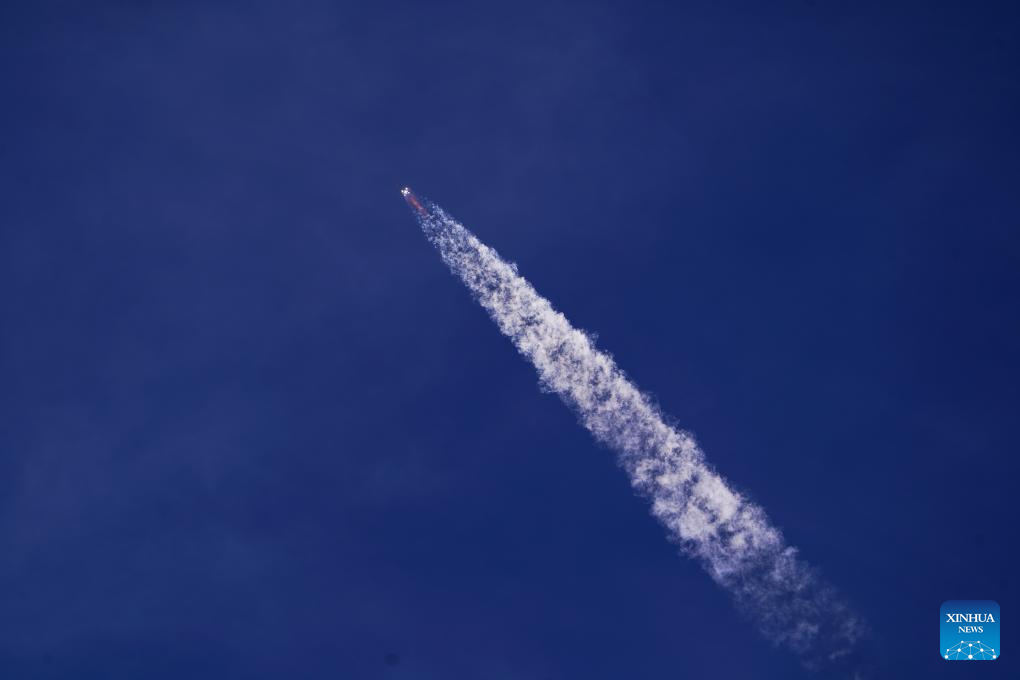
The Shenzhou-22 spaceship, atop a Long March-2F Y22 rocket, blasts off from the Jiuquan Satellite Launch Center in northwest China, Nov. 25, 2025. China launched the Shenzhou-22 spaceship from the Jiuquan Satellite Launch Center in northwest China at 12:11 p.m. (Beijing Time) on Tuesday, successfully accomplishing the first emergency launch mission in the country's manned space program.
About 10 minutes after the launch, the spaceship separated from the rocket and entered its designated orbit. The China Manned Space Agency declared the launch mission a complete success. (Photo by He Gaobing/Xinhua)
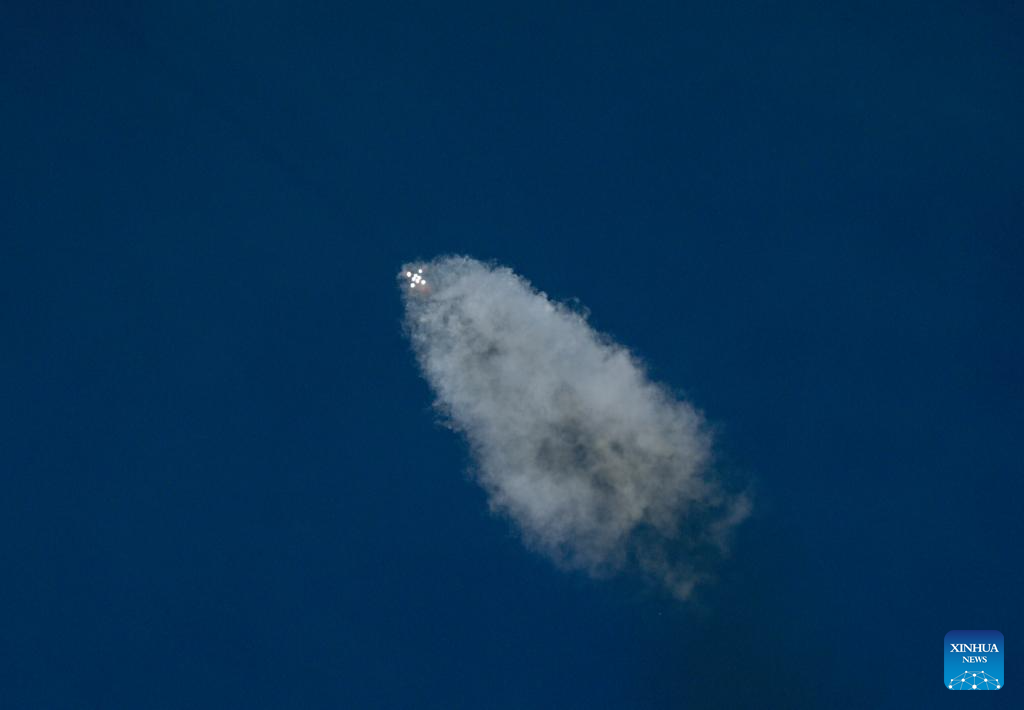
The Shenzhou-22 spaceship, atop a Long March-2F Y22 rocket, blasts off from the Jiuquan Satellite Launch Center in northwest China, Nov. 25, 2025. China launched the Shenzhou-22 spaceship from the Jiuquan Satellite Launch Center in northwest China at 12:11 p.m. (Beijing Time) on Tuesday, successfully accomplishing the first emergency launch mission in the country's manned space program.
About 10 minutes after the launch, the spaceship separated from the rocket and entered its designated orbit. The China Manned Space Agency declared the launch mission a complete success. (Xinhua/Lian Zhen)

A Long March-2F Y22 rocket carrying the Shenzhou-22 spaceship blasts off from the Jiuquan Satellite Launch Center in northwest China, Nov. 25, 2025. China launched the Shenzhou-22 spaceship from the Jiuquan Satellite Launch Center in northwest China at 12:11 p.m. (Beijing Time) on Tuesday, successfully accomplishing the first emergency launch mission in the country's manned space program.
About 10 minutes after the launch, the spaceship separated from the rocket and entered its designated orbit. The China Manned Space Agency declared the launch mission a complete success. (Xinhua/Zhang Bin)

A Long March-2F Y22 rocket carrying the Shenzhou-22 spaceship blasts off from the Jiuquan Satellite Launch Center in northwest China, Nov. 25, 2025. China launched the Shenzhou-22 spaceship from the Jiuquan Satellite Launch Center in northwest China at 12:11 p.m. (Beijing Time) on Tuesday, successfully accomplishing the first emergency launch mission in the country's manned space program.
About 10 minutes after the launch, the spaceship separated from the rocket and entered its designated orbit. The China Manned Space Agency declared the launch mission a complete success. (Photo by Bai Long/Xinhua)
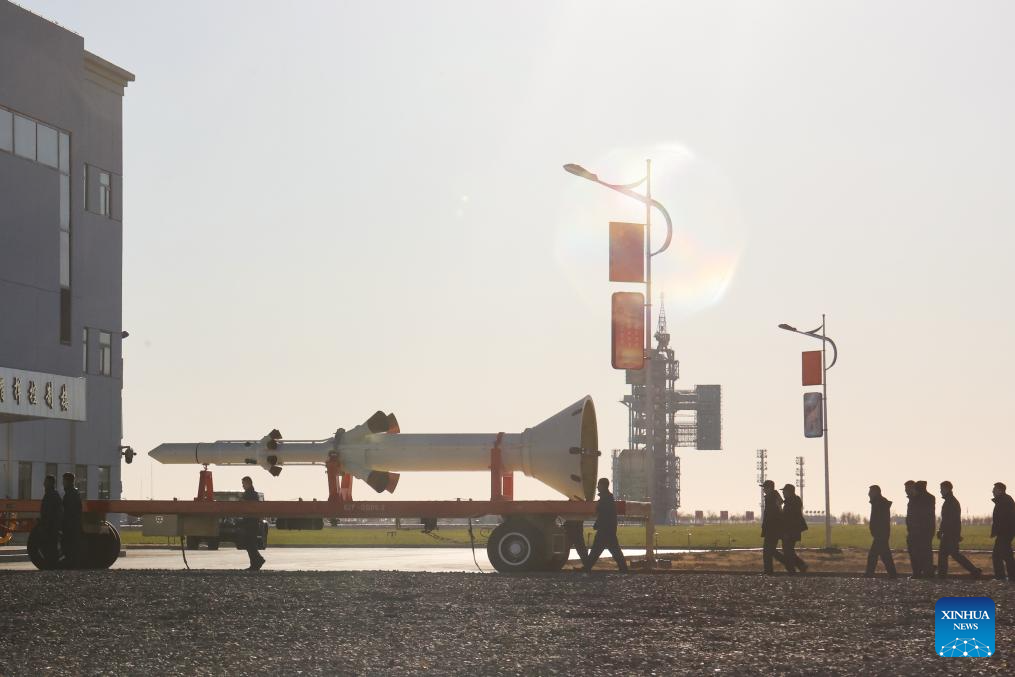
The escape tower is being transferred on Nov. 18, 2025. China on Tuesday launched the Shenzhou-22 spaceship to provide a return vessel for the three Shenzhou-21 astronauts in orbit. This momentous occasion marked the accomplishment of the first emergency launch mission in the country's manned space program.
The launch of the new spaceship followed the return of the three Shenzhou-20 astronauts back to Earth on Nov. 14 by the Shenzhou-21 spacecraft.
The return mission, initially scheduled for Nov. 5 by the Shenzhou-20 spaceship, was delayed due to a suspected debris impact on the Shenzhou-20 return capsule's viewport window.
The Long March-2F Y22 rocket and the Shenzhou-22 spaceship -- already on standby at the launch site upon the contingency -- were swiftly prepared for launch.
After the initiation of the contingency plan, all teams involved in the project demonstrated a composed and methodical approach.
Within 20 days, all participating research and testing units collaborated and completed a series of critical tasks, including risk assessment, solution analysis and decision-making, personnel and material deployment, crew return aboard a replacement vessel, as well as an emergency launch, offering a world-class example of managing an in-orbit emergency, the China Manned Space Agency said.
The success of this mission fully demonstrated the strengths of China's new system for mobilizing resources nationwide, it noted. (Photo by Pang Zhaoqi/Xinhua)
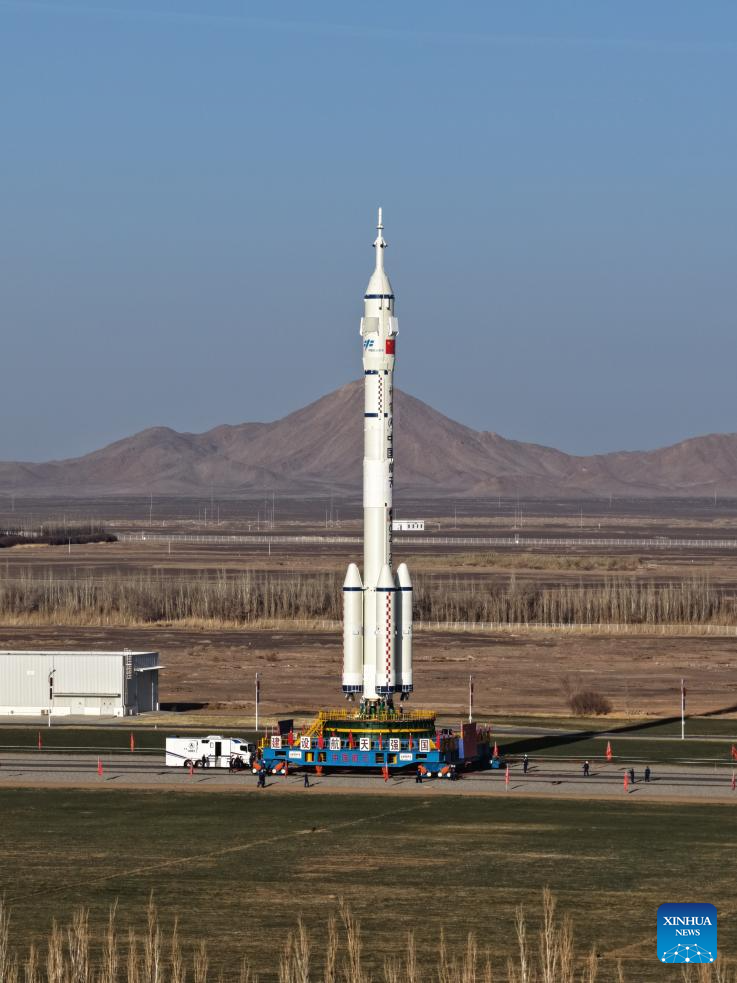
This photo taken on Nov. 20, 2025 shows the combination of the Shenzhou-22 spaceship and the Long March-2F Y22 rocket being transferred to the launching area. China on Tuesday launched the Shenzhou-22 spaceship to provide a return vessel for the three Shenzhou-21 astronauts in orbit. This momentous occasion marked the accomplishment of the first emergency launch mission in the country's manned space program.
The launch of the new spaceship followed the return of the three Shenzhou-20 astronauts back to Earth on Nov. 14 by the Shenzhou-21 spacecraft.
The return mission, initially scheduled for Nov. 5 by the Shenzhou-20 spaceship, was delayed due to a suspected debris impact on the Shenzhou-20 return capsule's viewport window.
The Long March-2F Y22 rocket and the Shenzhou-22 spaceship -- already on standby at the launch site upon the contingency -- were swiftly prepared for launch.
After the initiation of the contingency plan, all teams involved in the project demonstrated a composed and methodical approach.
Within 20 days, all participating research and testing units collaborated and completed a series of critical tasks, including risk assessment, solution analysis and decision-making, personnel and material deployment, crew return aboard a replacement vessel, as well as an emergency launch, offering a world-class example of managing an in-orbit emergency, the China Manned Space Agency said.
The success of this mission fully demonstrated the strengths of China's new system for mobilizing resources nationwide, it noted. (Photo by Hao Yutong/Xinhua)
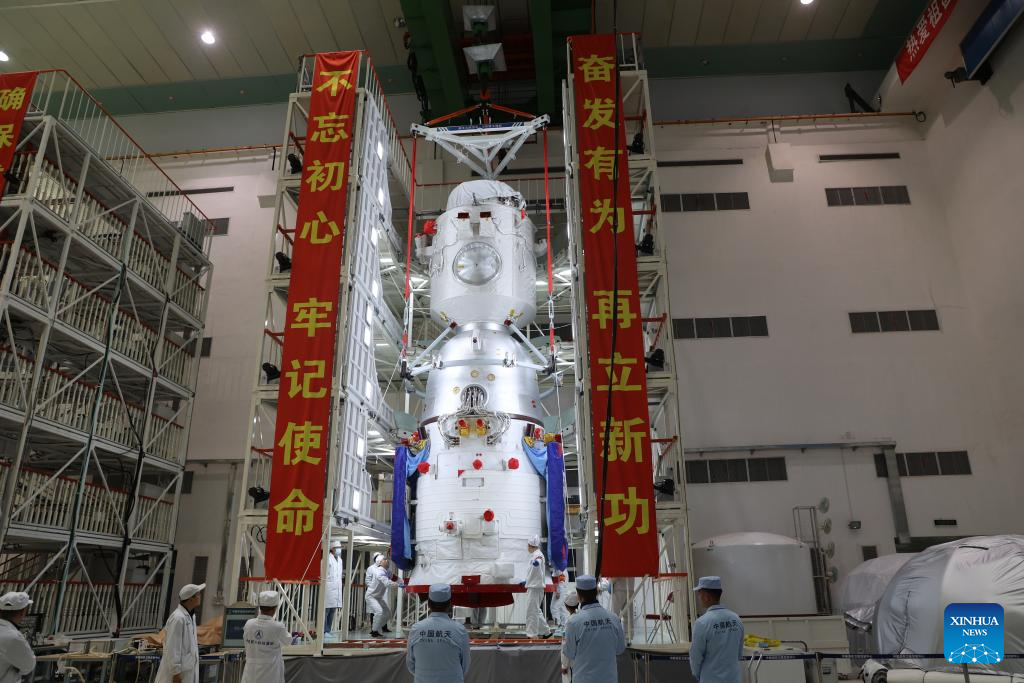
The Shenzhou-22 spacecraft is being hoisted on Nov. 12, 2025. China on Tuesday launched the Shenzhou-22 spaceship to provide a return vessel for the three Shenzhou-21 astronauts in orbit. This momentous occasion marked the accomplishment of the first emergency launch mission in the country's manned space program.
The launch of the new spaceship followed the return of the three Shenzhou-20 astronauts back to Earth on Nov. 14 by the Shenzhou-21 spacecraft.
The return mission, initially scheduled for Nov. 5 by the Shenzhou-20 spaceship, was delayed due to a suspected debris impact on the Shenzhou-20 return capsule's viewport window.
The Long March-2F Y22 rocket and the Shenzhou-22 spaceship -- already on standby at the launch site upon the contingency -- were swiftly prepared for launch.
After the initiation of the contingency plan, all teams involved in the project demonstrated a composed and methodical approach.
Within 20 days, all participating research and testing units collaborated and completed a series of critical tasks, including risk assessment, solution analysis and decision-making, personnel and material deployment, crew return aboard a replacement vessel, as well as an emergency launch, offering a world-class example of managing an in-orbit emergency, the China Manned Space Agency said.
The success of this mission fully demonstrated the strengths of China's new system for mobilizing resources nationwide, it noted. (Photo by Li Yuxiang/Xinhua)
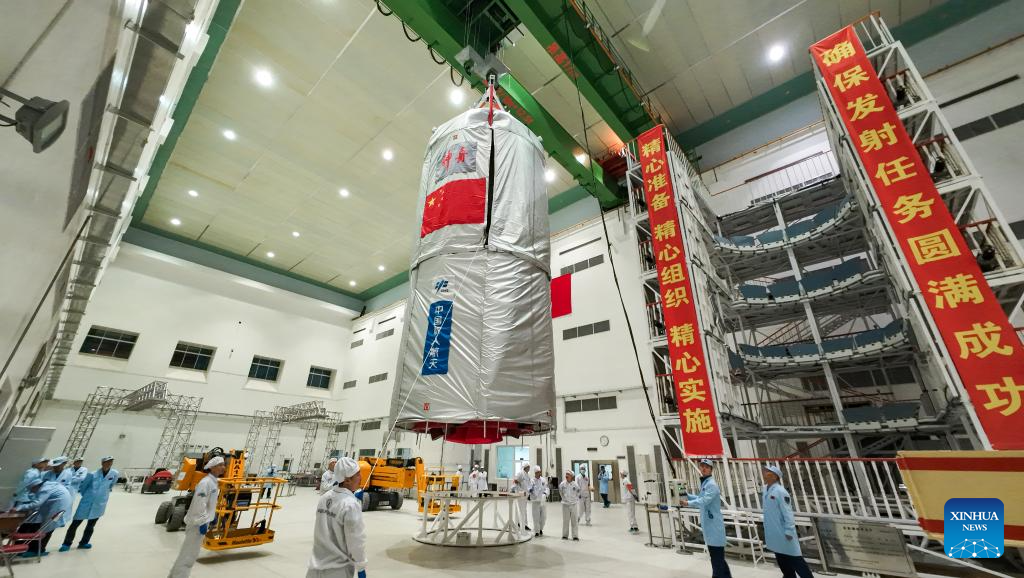
The Shenzhou-22 spacecraft is being hoisted on Nov. 12, 2025. China on Tuesday launched the Shenzhou-22 spaceship to provide a return vessel for the three Shenzhou-21 astronauts in orbit. This momentous occasion marked the accomplishment of the first emergency launch mission in the country's manned space program.
The launch of the new spaceship followed the return of the three Shenzhou-20 astronauts back to Earth on Nov. 14 by the Shenzhou-21 spacecraft.
The return mission, initially scheduled for Nov. 5 by the Shenzhou-20 spaceship, was delayed due to a suspected debris impact on the Shenzhou-20 return capsule's viewport window.
The Long March-2F Y22 rocket and the Shenzhou-22 spaceship -- already on standby at the launch site upon the contingency -- were swiftly prepared for launch.
After the initiation of the contingency plan, all teams involved in the project demonstrated a composed and methodical approach.
Within 20 days, all participating research and testing units collaborated and completed a series of critical tasks, including risk assessment, solution analysis and decision-making, personnel and material deployment, crew return aboard a replacement vessel, as well as an emergency launch, offering a world-class example of managing an in-orbit emergency, the China Manned Space Agency said.
The success of this mission fully demonstrated the strengths of China's new system for mobilizing resources nationwide, it noted. (Photo by Song Ying'ao/Xinhua)
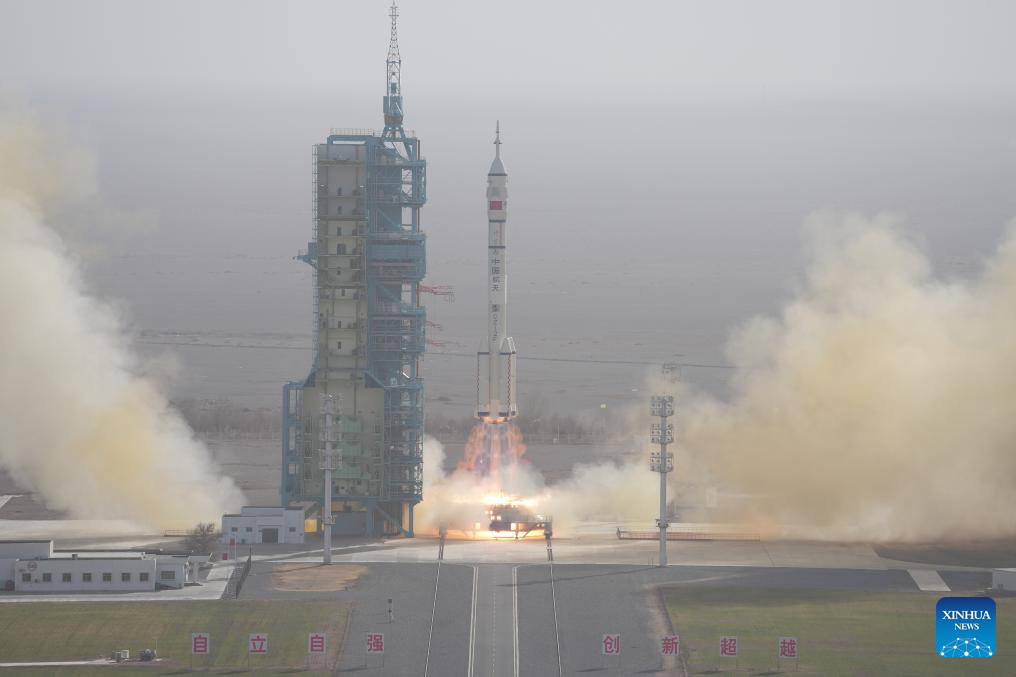
China launches the Shenzhou-22 spaceship from the Jiuquan Satellite Launch Center in northwest China on Nov. 25, 2025. China on Tuesday launched the Shenzhou-22 spaceship to provide a return vessel for the three Shenzhou-21 astronauts in orbit. This momentous occasion marked the accomplishment of the first emergency launch mission in the country's manned space program.
The launch of the new spaceship followed the return of the three Shenzhou-20 astronauts back to Earth on Nov. 14 by the Shenzhou-21 spacecraft.
The return mission, initially scheduled for Nov. 5 by the Shenzhou-20 spaceship, was delayed due to a suspected debris impact on the Shenzhou-20 return capsule's viewport window.
The Long March-2F Y22 rocket and the Shenzhou-22 spaceship -- already on standby at the launch site upon the contingency -- were swiftly prepared for launch.
After the initiation of the contingency plan, all teams involved in the project demonstrated a composed and methodical approach.
Within 20 days, all participating research and testing units collaborated and completed a series of critical tasks, including risk assessment, solution analysis and decision-making, personnel and material deployment, crew return aboard a replacement vessel, as well as an emergency launch, offering a world-class example of managing an in-orbit emergency, the China Manned Space Agency said.
The success of this mission fully demonstrated the strengths of China's new system for mobilizing resources nationwide, it noted. (Xinhua/Li Minggang)
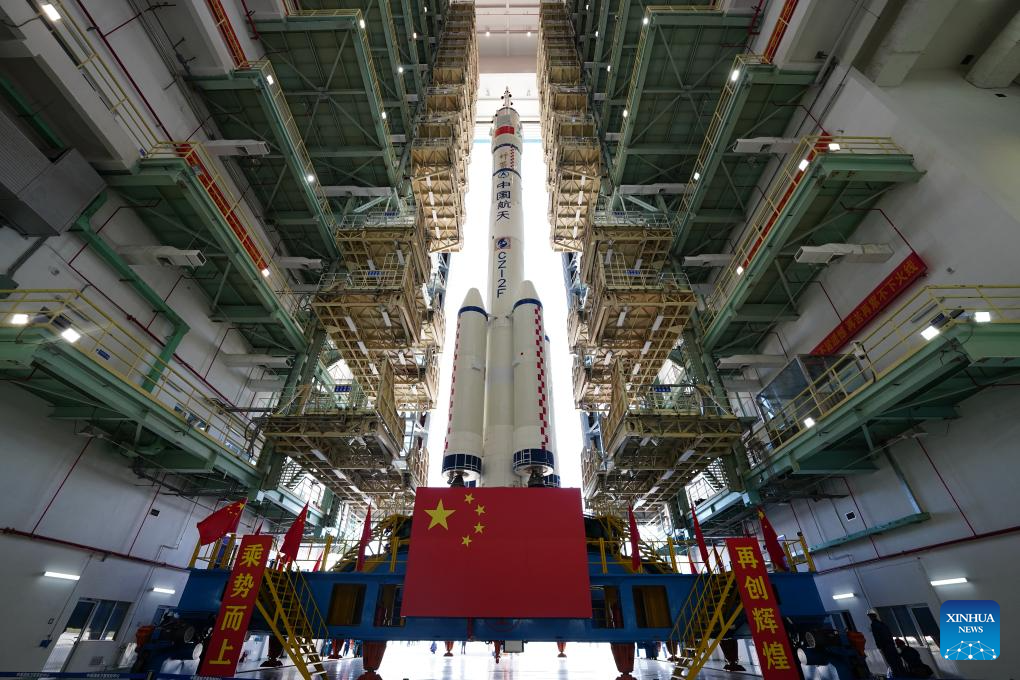
This photo taken on Nov. 20, 2025 shows the combination of the Shenzhou-22 spaceship and the Long March-2F Y22 rocket preparing to be transferred to the launching area. China on Tuesday launched the Shenzhou-22 spaceship to provide a return vessel for the three Shenzhou-21 astronauts in orbit. This momentous occasion marked the accomplishment of the first emergency launch mission in the country's manned space program.
The launch of the new spaceship followed the return of the three Shenzhou-20 astronauts back to Earth on Nov. 14 by the Shenzhou-21 spacecraft.
The return mission, initially scheduled for Nov. 5 by the Shenzhou-20 spaceship, was delayed due to a suspected debris impact on the Shenzhou-20 return capsule's viewport window.
The Long March-2F Y22 rocket and the Shenzhou-22 spaceship -- already on standby at the launch site upon the contingency -- were swiftly prepared for launch.
After the initiation of the contingency plan, all teams involved in the project demonstrated a composed and methodical approach.
Within 20 days, all participating research and testing units collaborated and completed a series of critical tasks, including risk assessment, solution analysis and decision-making, personnel and material deployment, crew return aboard a replacement vessel, as well as an emergency launch, offering a world-class example of managing an in-orbit emergency, the China Manned Space Agency said.
The success of this mission fully demonstrated the strengths of China's new system for mobilizing resources nationwide, it noted. (Photo by Li Yuxiang/Xinhua)
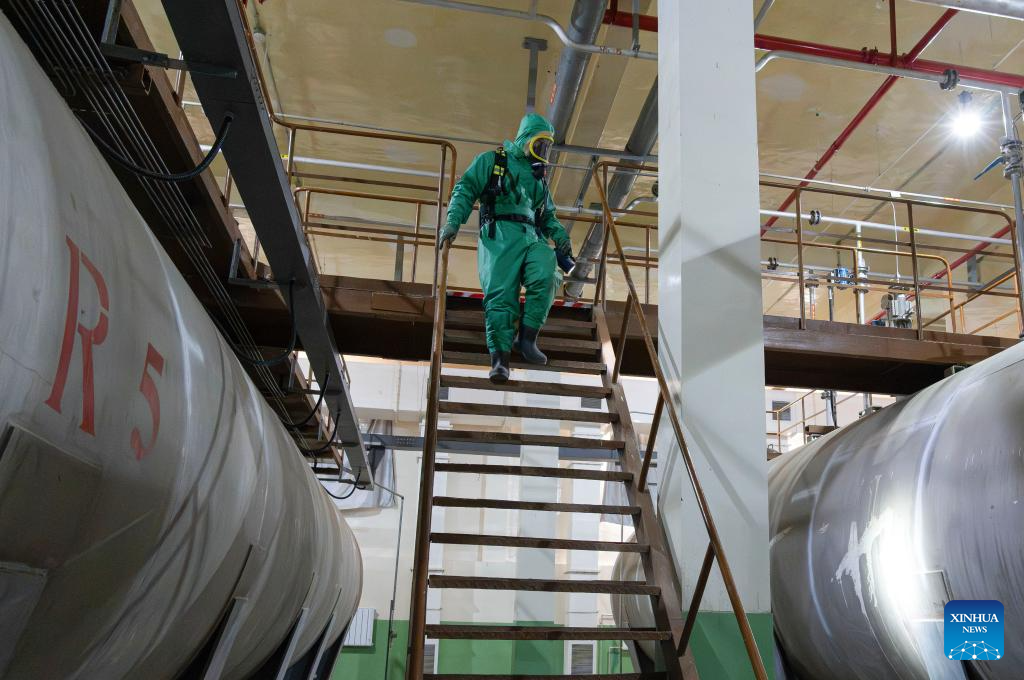
A staff member conducts pre-loading inspections of propellant in the loading area of Shenzhou-22 spaceship on Nov. 24, 2025. China on Tuesday launched the Shenzhou-22 spaceship to provide a return vessel for the three Shenzhou-21 astronauts in orbit. This momentous occasion marked the accomplishment of the first emergency launch mission in the country's manned space program.
The launch of the new spaceship followed the return of the three Shenzhou-20 astronauts back to Earth on Nov. 14 by the Shenzhou-21 spacecraft.
The return mission, initially scheduled for Nov. 5 by the Shenzhou-20 spaceship, was delayed due to a suspected debris impact on the Shenzhou-20 return capsule's viewport window.
The Long March-2F Y22 rocket and the Shenzhou-22 spaceship -- already on standby at the launch site upon the contingency -- were swiftly prepared for launch.
After the initiation of the contingency plan, all teams involved in the project demonstrated a composed and methodical approach.
Within 20 days, all participating research and testing units collaborated and completed a series of critical tasks, including risk assessment, solution analysis and decision-making, personnel and material deployment, crew return aboard a replacement vessel, as well as an emergency launch, offering a world-class example of managing an in-orbit emergency, the China Manned Space Agency said.
The success of this mission fully demonstrated the strengths of China's new system for mobilizing resources nationwide, it noted. (Xinhua/Li Minggang)
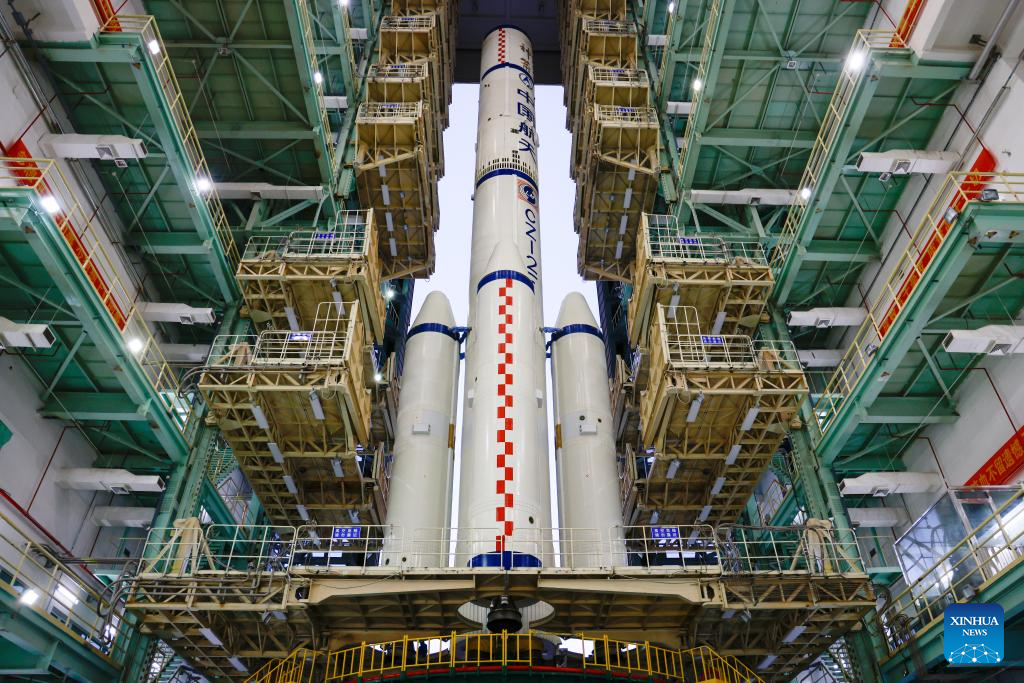
The Long March-2F Y22 rocket is transferred to the pre-launch test position on Nov. 8, 2025. China on Tuesday launched the Shenzhou-22 spaceship to provide a return vessel for the three Shenzhou-21 astronauts in orbit. This momentous occasion marked the accomplishment of the first emergency launch mission in the country's manned space program.
The launch of the new spaceship followed the return of the three Shenzhou-20 astronauts back to Earth on Nov. 14 by the Shenzhou-21 spacecraft.
The return mission, initially scheduled for Nov. 5 by the Shenzhou-20 spaceship, was delayed due to a suspected debris impact on the Shenzhou-20 return capsule's viewport window.
The Long March-2F Y22 rocket and the Shenzhou-22 spaceship -- already on standby at the launch site upon the contingency -- were swiftly prepared for launch.
After the initiation of the contingency plan, all teams involved in the project demonstrated a composed and methodical approach.
Within 20 days, all participating research and testing units collaborated and completed a series of critical tasks, including risk assessment, solution analysis and decision-making, personnel and material deployment, crew return aboard a replacement vessel, as well as an emergency launch, offering a world-class example of managing an in-orbit emergency, the China Manned Space Agency said.
The success of this mission fully demonstrated the strengths of China's new system for mobilizing resources nationwide, it noted. (Photo by Li Mingtang/Xinhua)

A staff member carries out battery handover and installation work on Nov. 16, 2025. China on Tuesday launched the Shenzhou-22 spaceship to provide a return vessel for the three Shenzhou-21 astronauts in orbit. This momentous occasion marked the accomplishment of the first emergency launch mission in the country's manned space program.
The launch of the new spaceship followed the return of the three Shenzhou-20 astronauts back to Earth on Nov. 14 by the Shenzhou-21 spacecraft.
The return mission, initially scheduled for Nov. 5 by the Shenzhou-20 spaceship, was delayed due to a suspected debris impact on the Shenzhou-20 return capsule's viewport window.
The Long March-2F Y22 rocket and the Shenzhou-22 spaceship -- already on standby at the launch site upon the contingency -- were swiftly prepared for launch.
After the initiation of the contingency plan, all teams involved in the project demonstrated a composed and methodical approach.
Within 20 days, all participating research and testing units collaborated and completed a series of critical tasks, including risk assessment, solution analysis and decision-making, personnel and material deployment, crew return aboard a replacement vessel, as well as an emergency launch, offering a world-class example of managing an in-orbit emergency, the China Manned Space Agency said.
The success of this mission fully demonstrated the strengths of China's new system for mobilizing resources nationwide, it noted. (Photo by Li Yuxiang/Xinhua)
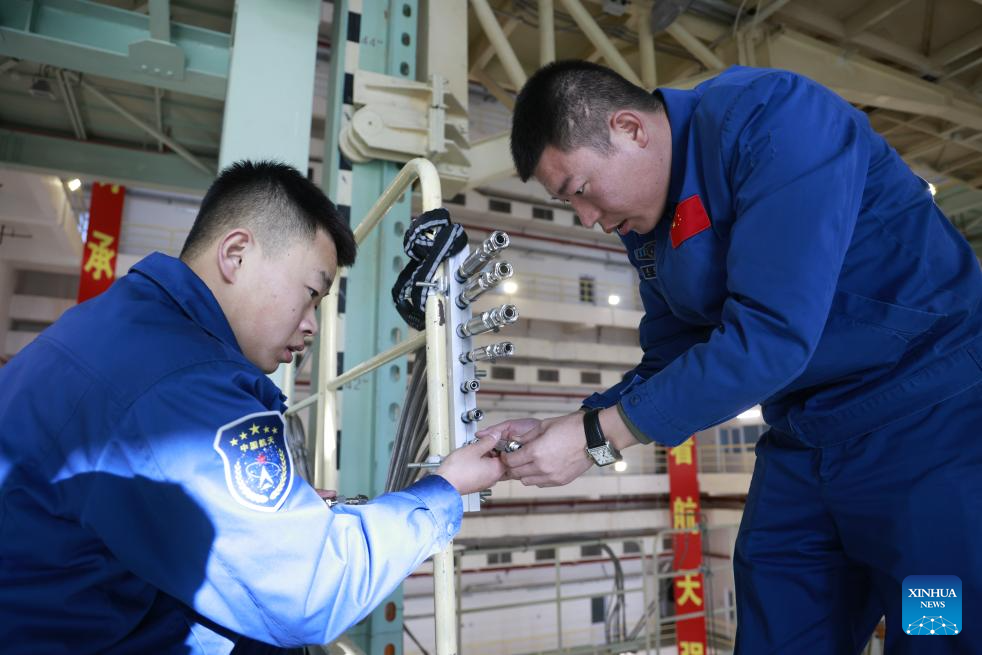
Staff members conduct operations on the gas supply pipelines of the Shenzhou-22 spaceship on Nov. 9, 2025. China on Tuesday launched the Shenzhou-22 spaceship to provide a return vessel for the three Shenzhou-21 astronauts in orbit. This momentous occasion marked the accomplishment of the first emergency launch mission in the country's manned space program.
The launch of the new spaceship followed the return of the three Shenzhou-20 astronauts back to Earth on Nov. 14 by the Shenzhou-21 spacecraft.
The return mission, initially scheduled for Nov. 5 by the Shenzhou-20 spaceship, was delayed due to a suspected debris impact on the Shenzhou-20 return capsule's viewport window.
The Long March-2F Y22 rocket and the Shenzhou-22 spaceship -- already on standby at the launch site upon the contingency -- were swiftly prepared for launch.
After the initiation of the contingency plan, all teams involved in the project demonstrated a composed and methodical approach.
Within 20 days, all participating research and testing units collaborated and completed a series of critical tasks, including risk assessment, solution analysis and decision-making, personnel and material deployment, crew return aboard a replacement vessel, as well as an emergency launch, offering a world-class example of managing an in-orbit emergency, the China Manned Space Agency said.
The success of this mission fully demonstrated the strengths of China's new system for mobilizing resources nationwide, it noted. (Photo by Li Mingtang/Xinhua)

Staff members inspect equipment status at a fire station at the launch site on Nov. 13, 2025. China on Tuesday launched the Shenzhou-22 spaceship to provide a return vessel for the three Shenzhou-21 astronauts in orbit. This momentous occasion marked the accomplishment of the first emergency launch mission in the country's manned space program.
The launch of the new spaceship followed the return of the three Shenzhou-20 astronauts back to Earth on Nov. 14 by the Shenzhou-21 spacecraft.
The return mission, initially scheduled for Nov. 5 by the Shenzhou-20 spaceship, was delayed due to a suspected debris impact on the Shenzhou-20 return capsule's viewport window.
The Long March-2F Y22 rocket and the Shenzhou-22 spaceship -- already on standby at the launch site upon the contingency -- were swiftly prepared for launch.
After the initiation of the contingency plan, all teams involved in the project demonstrated a composed and methodical approach.
Within 20 days, all participating research and testing units collaborated and completed a series of critical tasks, including risk assessment, solution analysis and decision-making, personnel and material deployment, crew return aboard a replacement vessel, as well as an emergency launch, offering a world-class example of managing an in-orbit emergency, the China Manned Space Agency said.
The success of this mission fully demonstrated the strengths of China's new system for mobilizing resources nationwide, it noted. (Photo by Yang Junjie/Xinhua)
点击右上角![]() 微信好友
微信好友
 朋友圈
朋友圈

请使用浏览器分享功能进行分享
